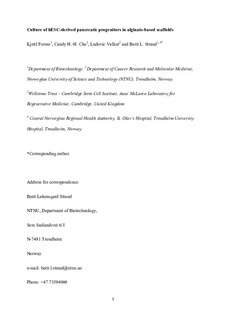Culture of hESC-derived pancreatic progenitors in alginate-based scaffold
Journal article, Peer reviewed
Accepted version
Permanent lenke
http://hdl.handle.net/11250/2464173Utgivelsesdato
2015Metadata
Vis full innførselSamlinger
Originalversjon
Journal of Biomedical Materials Research. Part A. 2015, 103 (12), 3717-3726. 10.1002/jbm.a.35507Sammendrag
The effect of alginate-based scaffolds with added basement membrane proteins on the in vitro development of hESC-derived pancreatic progenitors was investigated. Cell clusters were encapsulated in scaffolds containing the basement membrane proteins collagen IV, laminin, fibronectin, or extracellular matrix-derived peptides, and maintained in culture for up to 46 days. The cells remained viable throughout the experiment with no signs of central necrosis. Whereas nonencapsulated cells aggregated into larger clusters, some of which showed signs of morphological changes and tissue organization, the alginate matrix stabilized the cluster size and displayed more homogeneous cell morphologies, allowing culture for long periods of time. For all conditions tested, a stable or declining expression of insulin and PDX1 and an increase in glucagon and somatostatin over time indicated a progressive reduction in beta cell-related gene expression. Alginate scaffolds can provide a chemically defined, xeno-free and easily scalable alternative for culture of pancreatic progenitors. Although no increase in insulin and PDX1 gene expression after alginate-immobilized cell culture was seen in this study, further optimization of the matrix physicochemical and biological properties and of the medium composition may still be a relevant strategy to promote the stabilization or maturation of stem cell-derived beta cells.
